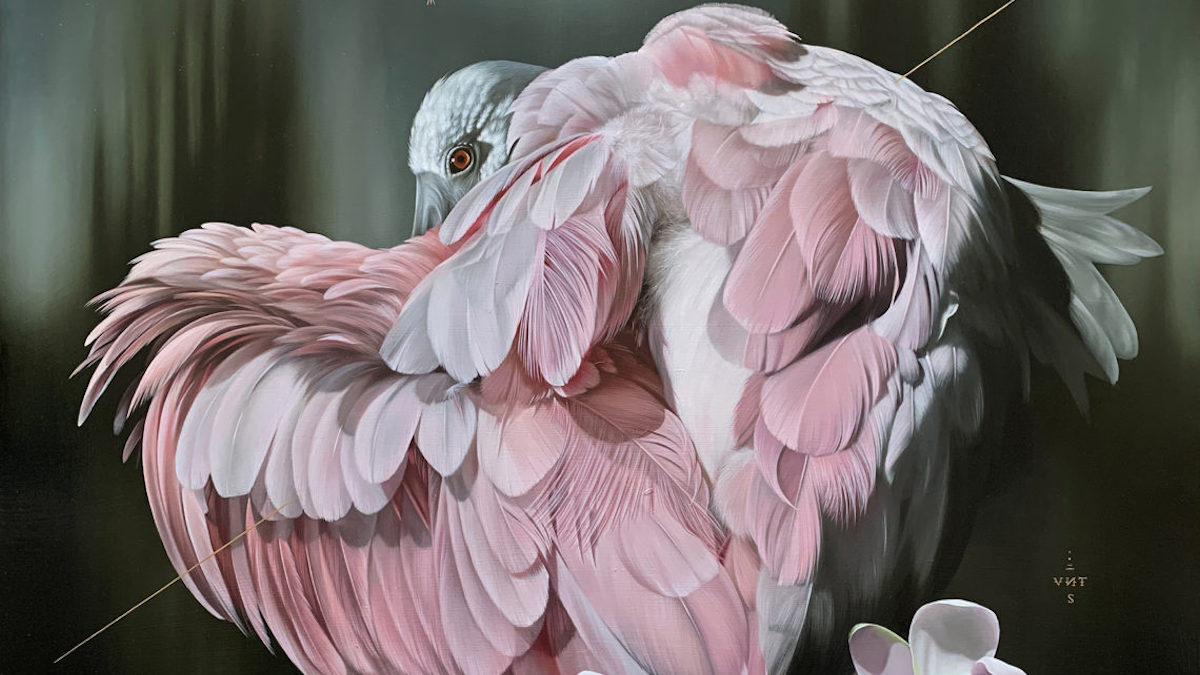Josie Morway never thought painting would be her full-time career and took numerous classes in college--and none were for painting.
But as she explained in an in-depth interview with Kinute, painting continued to draw her in from a young age.
Painting is her passion, as is conservation, which is evident in her art.
Growing in popularity, Morway's paintings are getting even more of a boost after one was commissioned by John Oliver and featured on the Last Week Tonight show. The painting went viral in September, and it was entered into the Federal Duck Stamp competition.
Her painting showcased some clever humor that poked fun at a new competition rule that was criticized by many, and in turn was disqualified from the competition. In an Instagram post, she wrote, "If you can believe it, my entry to the Federal Duck Stamp competition this year did not win. It did, however, mark my first collaboration with John Oliver and @lastweektonight, who commissioned this piece to draw attention to the important and yet always slightly absurd competition, and most importantly to raise money for conservation."
Most of Josie Morway’s work promotes conservation through her vivid and vibrant colorful bird paintings and occasionally of other wildlife. She describes her featured work and what inspired her to paint them on her website.
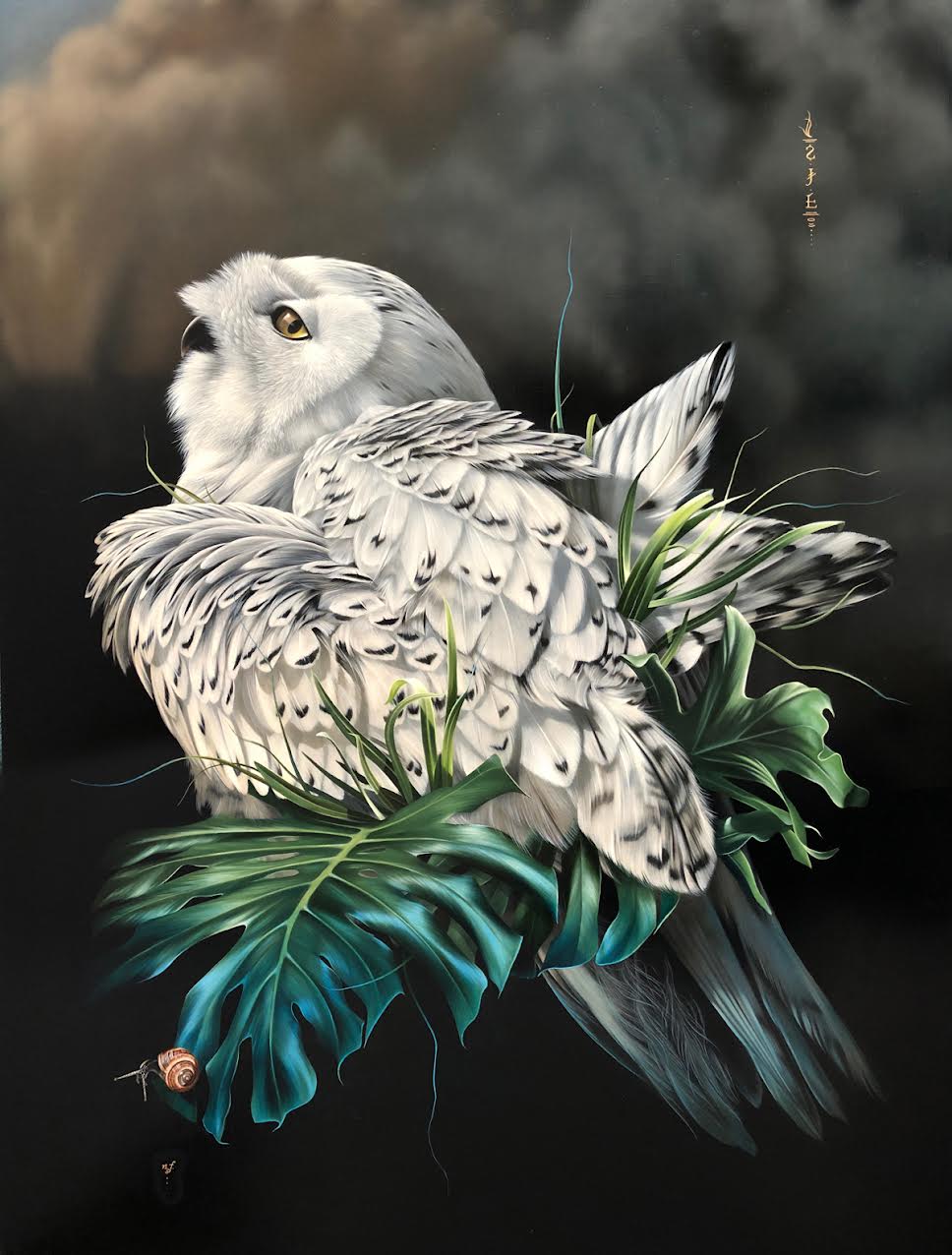
"Cold Chain" | Josie Morway
For instance, she wrote about her "Watershed" painting, "While making the work for 'Watershed' I’ve been quite literally thinking about water. The substance that’s within all of us, the most crucial central element in our ecosystem, our bodies, etc.... I’ve been thinking about water rights; who has them and who doesn’t, and about the movements and state changes of water. About the way ice is disappearing while floods increase in previously safe areas, about places inundated by saltwater as seas rise while even more places are suddenly without water… losing crops, losing drinking water. About pollution and diversion of bodies of water, but also about the redemptive nature of rain, of water’s capacity to heal."
She turned to birds to detail the change in the "liquid environment," she wrote. "Couldn’t resist the double-entendre in the name 'Watershed' as well, since we’re at a “watershed moment” in human-caused climate change."
Now she's busy working on a solo show dubbed "Wealth and Hellness," which will be on display at Corey Helford Gallery in Los Angeles. "Wealth and Hellness" explores how things go bad when "privileged" humans decide to reconnect with nature, her Instagram showed.
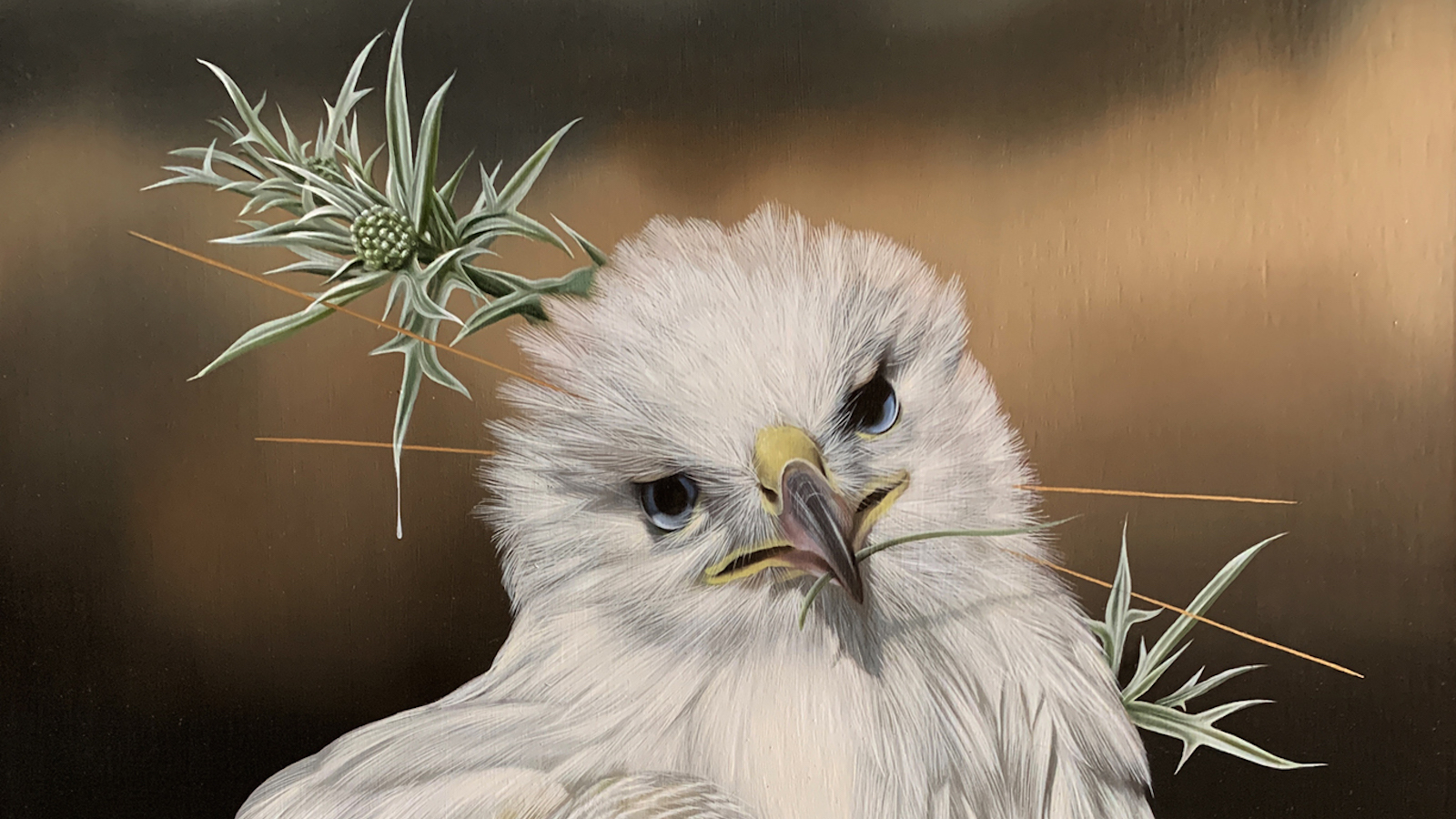
"Rise" | Josie Morway
In an interview with Kinute, Morway discussed her journey as an artist, her focus on birds in her paintings, her inspiration and her current new project.
When did your journey as an artist begin? Have you always focused on wildlife?
Probably began as a kid. I’ve always drawn, painted, made things, and my parents were very supportive and encouraging of those pursuits. Honestly, I often feel like art chose me, in the way it might always have to. I once read an essay about writing from an author who was essentially like “my advice to aspiring writers is; if you don’t absolutely have to write, don’t do it.” It sounds harsh, but I really dug this frank approach. Like, making art (or music, writing, etc.) is not an easy path if you’re looking for a reasonable career, financial and emotional security. It’s unlikely that you’ll succeed if you’re not driven by some giant internal need, and even then it’s not that likely.
I went to seven different colleges for undergrad, none of them for painting, and have had a lot of jobs I really planned to pursue. I’ve done GIS mapping, data visualization, design, majored in environmental science, etc. etc… but no matter what I believed I was focusing on, I would always end up “stealing” hours to paint. I honestly don’t remember when the balance started to tip and art became my full-time gig; but at a certain point, I think it’s true that the world tells us what it wants from us. The world seems to want my paintings, and it doesn’t necessarily want my writing or my urban planning, even if that’s what I’d intended to offer. I recently read about a Marxist geographer and I was like “oh man, I didn’t know Marxist geographer was a job title, I want to be one of those! But the world wants me to make these silly bird paintings...
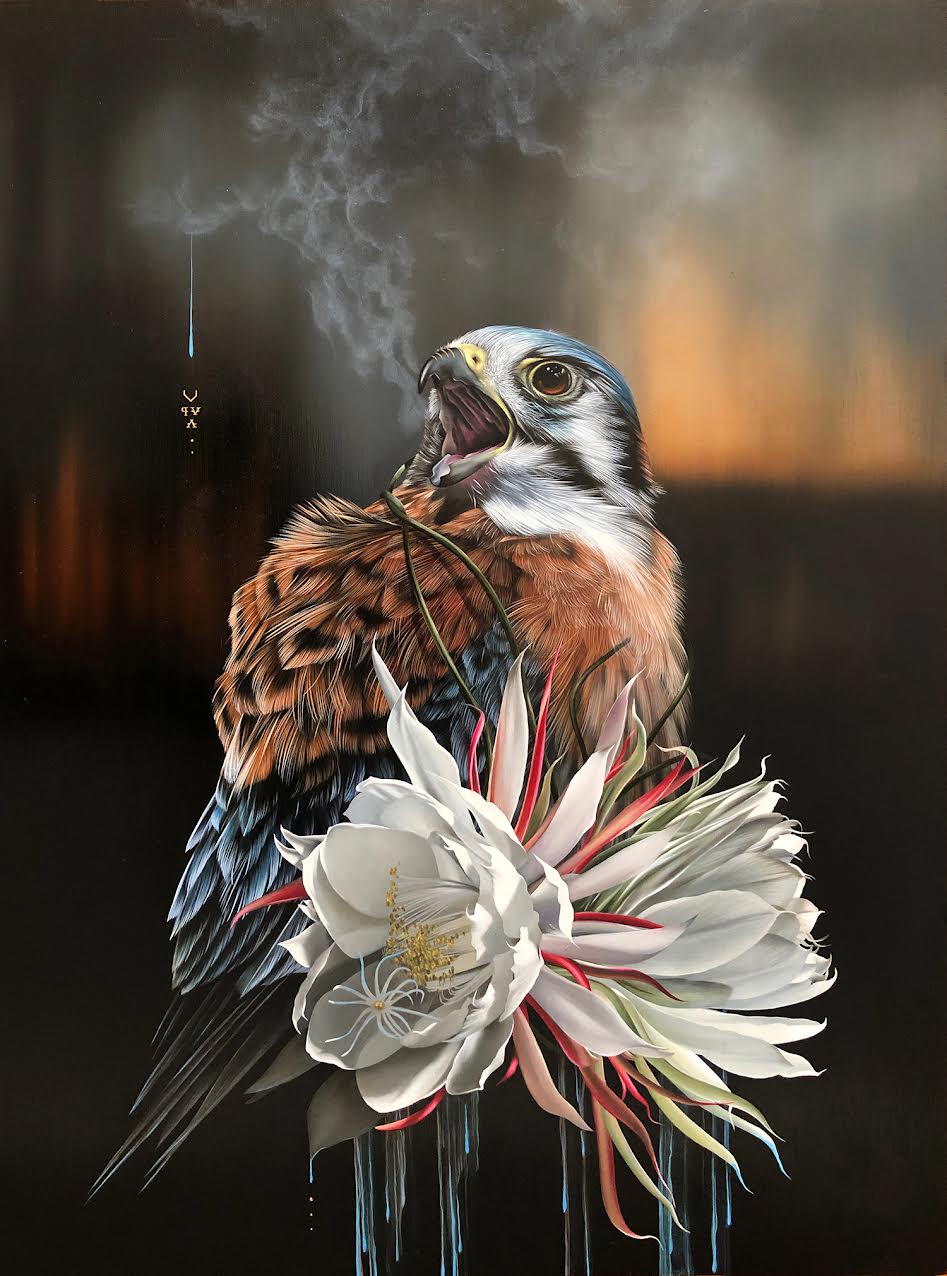
"Distiller" | Josie Morway
What is your fascination with birds? How did you choose this theme? When and/or how do you decide to incorporate other wildlife into your work?
That’s another thing that’s hard for me to answer! Early on my compulsion was to paint figures and buildings, portraits and power lines (literally, I painted pictures of power line pylons all the time). I painted my first bird at the prompting of a friend, and I’ve often claimed that it was a “random” direction that just hooked me. But the more I think about it, the more I doubt that can be true. I’ve been really passionate about conservation, the natural world and especially wildlife for my whole life, and birds are such amazing messengers when it comes to these topics. They’re amazing examples of natural beauty, adaptation, diversity, resiliency. And yet they’re also often among the first species to suffer from various forms of extraction and exploitation, habitat loss and climate change. They have such presence, such a gaze, that they can seem to be communicating with us in a really familiar way, and yet of course, they’re completely alien to us and unconcerned with what we might want to project onto them. I hope to portray birds in a manner that tempts you to “identify” with them, to look into their eyes and wonder at their agendas, but ultimately to be reminded that they are utterly unknowable to us. And that that is fine.
I feel the same about most wildlife and do enjoy incorporating other species, but I haven’t gotten as obsessive about them. I need to interrogate this further, as I’m not sure if I’m really more interested in birds, or if I’m also a little paralyzed by the idea that people expect BIRDS from me and I don’t want to disappoint.
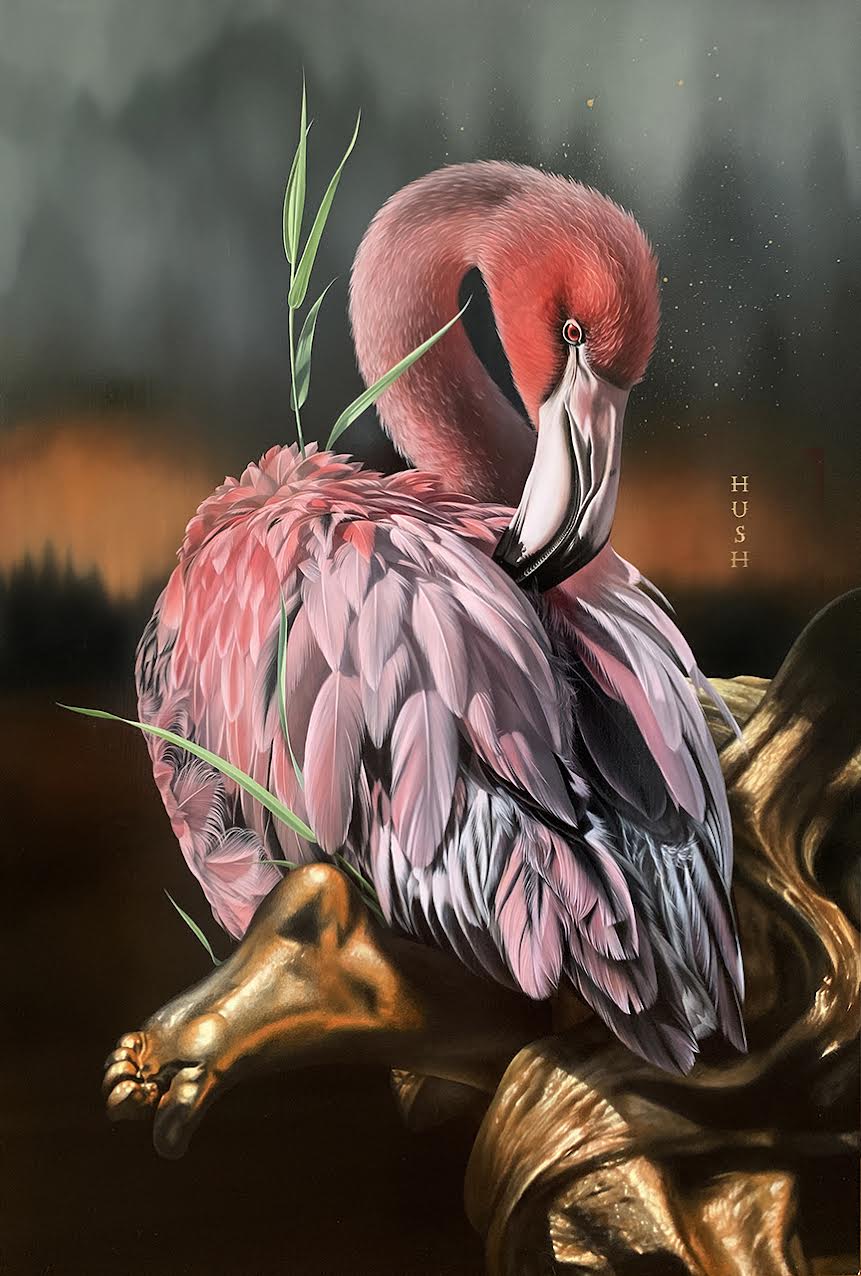
"Stories" | Josie Morway
What role do the outdoors play in your paintings?
Well, the outdoors is pretty much at the root of it all, now. All of my art is about the natural world and is essentially a plea for attention and for us to stop our collision course with disaster. To disrupt the extractive, exploitative, capitalist approach that we’re all funneled into, as humans and perhaps especially as Americans. I’ve never been sure if art can really make a huge difference, but I can hope that at least I can stop a viewer in their tracks and make them appreciate natural beauty for a moment, perhaps rethink the way they’re moving through the world and overlooking the ecosystems and species around us, the natural world that we are a part of even as we too often close our doors and forget about it.
To go further, lately, I’ve been thinking a lot about how even humans who “love nature” can really miss the boat, can do tons of damage by projecting human priorities onto the natural world. Once we realize the power of nature, we tend to demand a lot from it; that it heal us, inspire us, entertain us. There’s a real boom in “outdoorsiness” right now, and look at all the new forms of harm we’ve conjured up, like the ecosystems destroyed by thousands of people demanding to see a super-bloom, the history erased by people climbing, hiking or driving over sacred wilderness.
I’ve always wanted to call my viewer’s attention to wildlife with the intention of sparking a love of it, but now I realize there’s more nuance needed. We need a love of nature that also knows how to leave it the hell alone if you know what I mean. Can we have a reverence for nature without placing our needs at the center of it, making it about us and our experience of it? I want to be clear that I’m including myself in this “we.” I’m guilty of this same fetishization of nature and of projecting my own agenda and emotions onto the wildlife I paint!
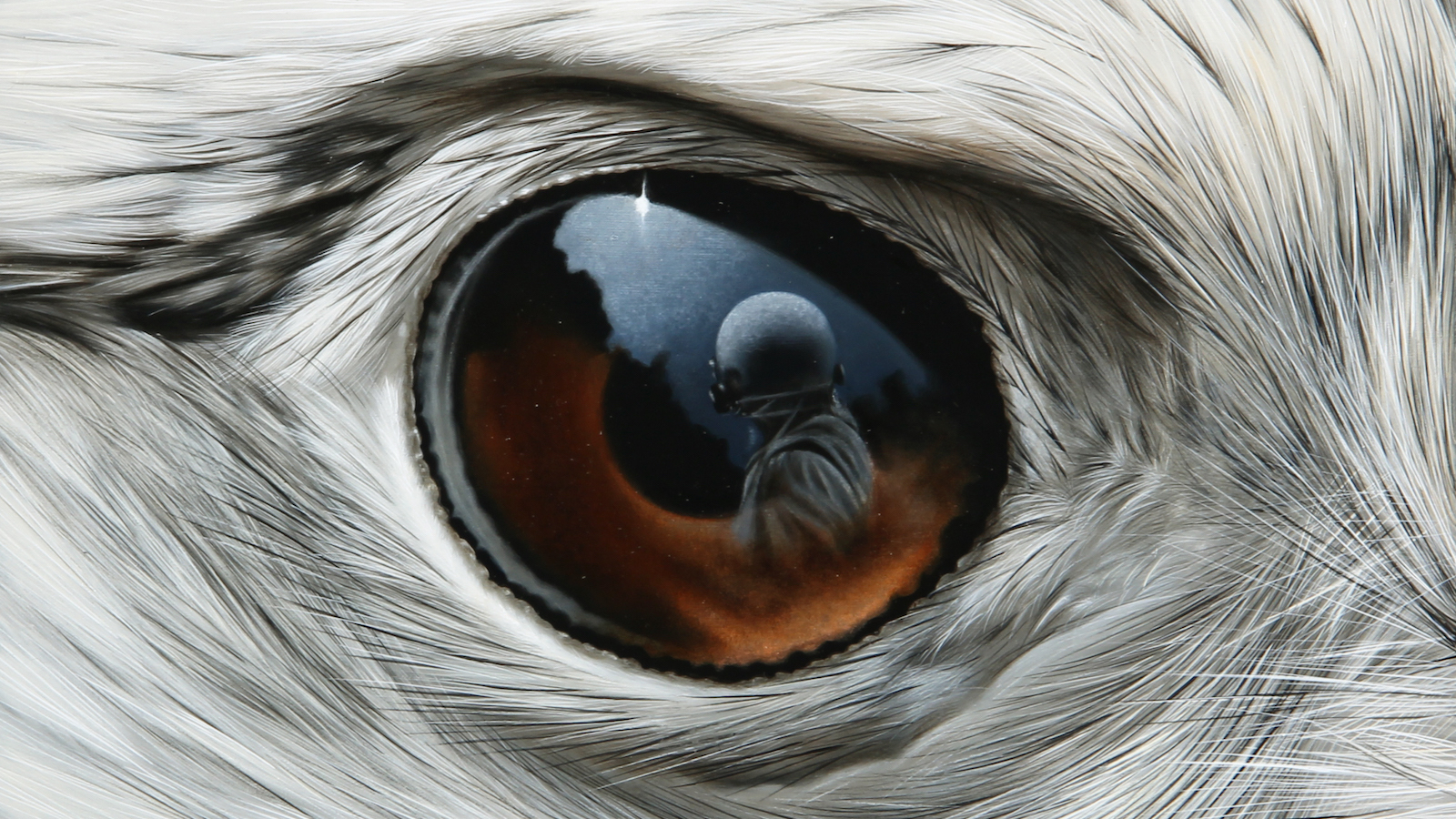
"Witness-2" | Josie Morway.
What inspires your creativity?
Ooh, who really knows? Honestly, I don’t spend much time in galleries or museums so it’s not formal “art.” I take in an absolutely absurd amount of the written word… like novels, audiobooks, articles and essays, poetry… which certainly is the foundation of most of my ideas about the world, my inner dialogues, etc. But maybe I mention that so prominently because we’ve just come through almost two years of relative isolation and “lockdown” where I’ve been at home or in the studio, so the written word has been the main way I can explore the world.
Because in normal times, I know that when I feel a need for inspiration I just need to go out and move through the world. Whether it’s major travel or just a run through an unfamiliar part of my own city, a change of perspective always fills me up. I absolutely love traveling by train or bus, and I’ve stuck with running for decades (despite it earning me a foot surgery this year) simply because I love how it allows me to pass through neighborhoods, parks, city streets, alleyways, at this perfect pace… fast enough to be exciting but slow enough for attention and care. It’s funny... my paintings always return to wildlife and the natural world, and I mountain bike and hike and spend a lot of time in nature, but when I really need inspiration I tend to seek out urban settings and built environments, graffiti, old signage and murals, outdated infrastructure, all of that texture and color. I suspect it’s not that cities inspire my content in any way, but just that all this input helps shake up and refresh my perspective and maybe even just helps to highlight the contrasts between fragile nature and human hubris.
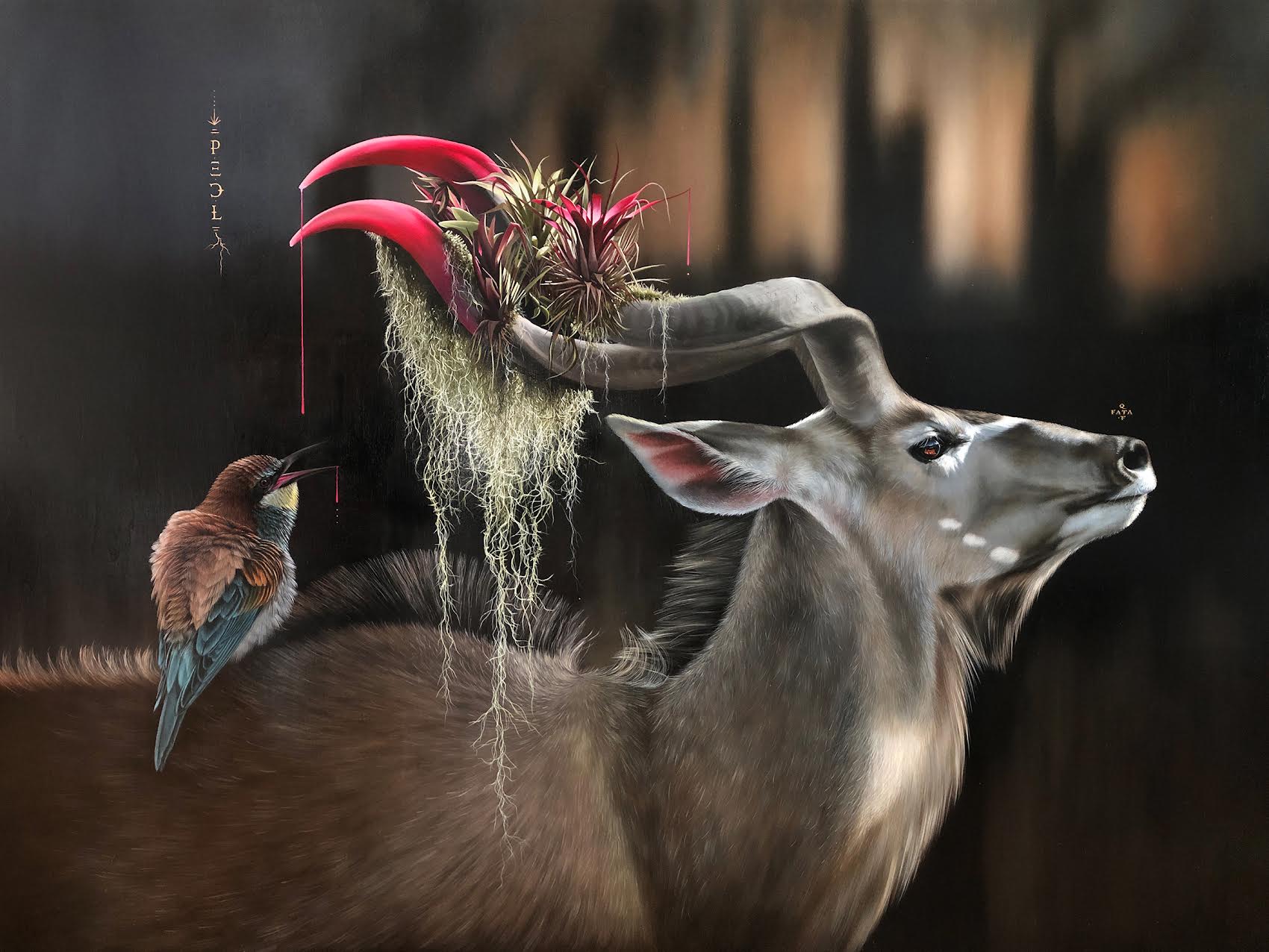
"Bearer" | Josie Morway.
When creating a painting, what materials and techniques do you like to use?
Aside from my occasional mural work, which is a totally different process, I essentially always work in oil paint on wooden panel. I’m not a very “painterly” painter… like you’re not going to find a lot of deep texture on my work or paint on my studio floor. I work in fairly controlled thin layers and glazes, building up shadow, highlight and detail as I go. The most impulsive part of my process is usually at the end when I finish up a piece using splatter or bits of spray paint, drips, or smears of wet paint to get the final feeling that I want.
Do you have a painting you’re most proud of?
Good but hard question! I think if I’m doing things right it should always be my most recent painting, right? My themes and directions are always evolving, so I’m mostly excited about the pieces that are in my studio right now, or the ones most recently on display. That said, sometimes I need a little SPACE from a piece after I work on it for so long… so occasionally I come across something from the past that surprises me, like “oh hey, that was actually a really nice piece! How did I do that?”
If I had to pick something in particular, I’m still not tired of my piece "Toward New Gardens" that shows a barn owl perched atop the headless Christopher Columbus statue… it was beheaded in real life last year, just a few miles from my studio. I love the totally deadpan look on the owl’s face, as it takes over the spot with absolutely no interest in our debates over who should be memorialized and who condemned.
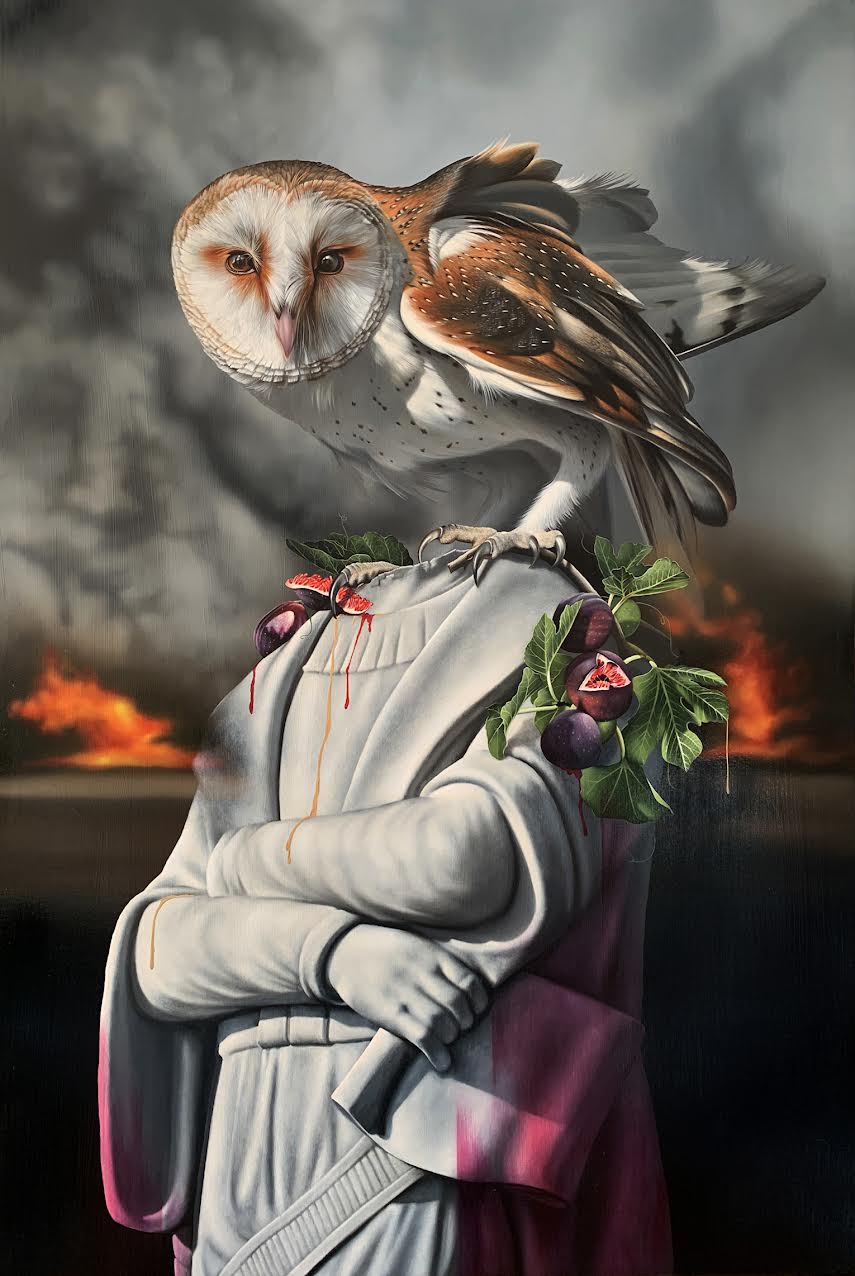
One of Morway's favorite pieces, "Toward New Gardens" | Josie Morway.
If your audience could only get one takeaway from your paintings, what would it be?
Slow down for a moment, give everything you think you know a second thought.
I see one of your paintings was featured on the Last Week Tonight show to raise funds and awareness for conservation—so cool! What was that process like? Can you tell us about the painting?
Super fun! Last Week Tonight contacted me out of the blue about commissioning a painting, and then we had a meeting where they revealed that I’d be entering the Federal Duck Stamp competition. It was the perfect project for me, as I knew I’d have a chance to raise a lot of money for conservation, but also turn the rules on their head a bit and add some humor to the competition. During the Trump Administration, a rule was added that every entry to the competition must include some element of hunting imagery. This frustrated a lot of artists (either because they are against hunting or just don’t like to have so many rules applied to their creativity), and the rule will actually be removed in next year’s competition… but it gave me the perfect opportunity for parody. My painting is of a redhead duck gazing knowingly at the viewer while training its own gun on a hunter, who in turn is aiming at another duck. Some people have interpreted my piece as strongly anti-hunter, which isn’t entirely the case. Hunting isn't for me, but hunters have actually been some of the strongest proponents and supporters of conservation, especially when it comes to wetlands and migratory birds. I just think every affinity group – whether it be hunters or artists – can benefit from taking themselves a bit less seriously. As a side note, I especially love thinking of how excited my late father would be about this project. He was an artist who carved amazingly realistic ducks and birds, and the only thing he loved more than wildlife conservation was f---ing with rules… so he would have been thrilled by this project.
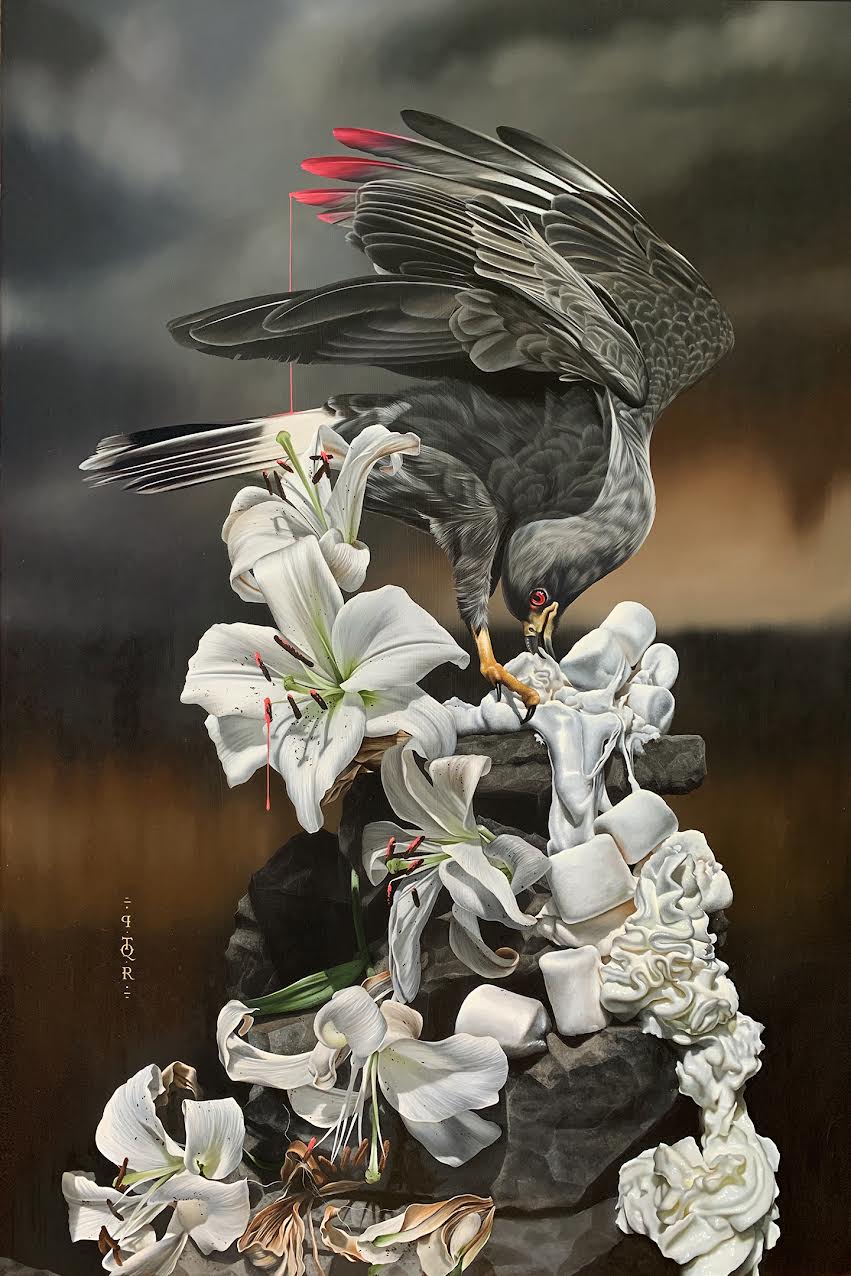
"Frill" | Josie Morway.
What is the Federal Duck Stamp competition?
The duck stamp itself – the physical stamp – is essentially a license that any waterfowl hunter has to buy and carry every year. Collectors and conservationists also buy the stamp, and the money goes directly to the Migratory Bird Conservation Fund, which purchases and protects wetlands and wildlife habitats. The stamp program has raised over $800 million for conservations since it began and has been called “one of the most successful conservation programs ever initiated.” Since the stamp is so widely known and purchased, it’s become a really heated competition for artists to create the image that’s featured each year. As John Oliver picked up on, a lot of drama has grown up around the winners. A few artists have won over and over, and it’s become a tradition for other artists to try to unseat those winners, sometimes through pure skill and practice, sometimes via humor and parody.
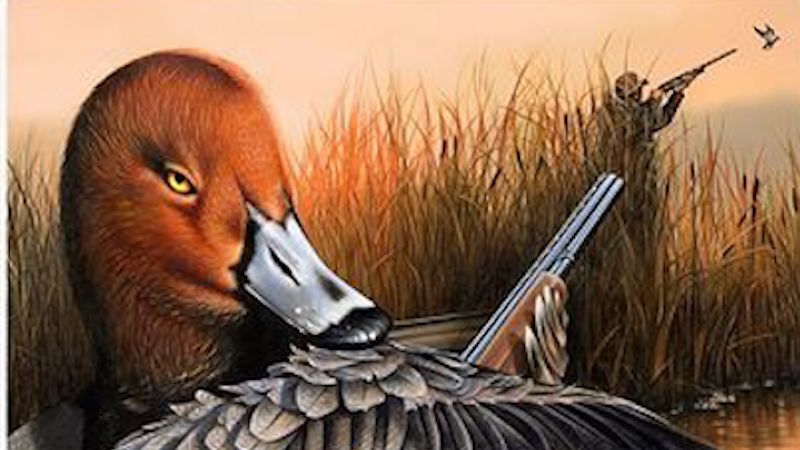
Morway's entry into the Federal Duck Stamp competition | Josie Morway.
Can you tell us about the show you’re currently working on called “Wealth and Hellness"? What’s that about? How is it different from your previous work? How is it similar?
It’ll certainly be recognizable as a continuation of the work I’ve been doing. I’m painting wildlife and plants and continuing to focus on the collision between the human and natural worlds. I’ve been thinking about how humans have become completely disconnected and alienated from the natural world, and even more about what happens when they’re then awakened to that disconnection and try to heal it. Doesn’t it seem like when humans – especially those of us who are the wealthiest, whitest and most privileged – decide to “reconnect with nature," that’s when things go even… more wrong? I’m thinking again of the trampling of super-blooms and sacred ecosystems for Instagram photos. But I think this strange overcorrection really reaches its apotheosis with the wellness industry, which is utterly booming. (Thus, the play on “health and wellness.: To be honest I had a dream that I made a solo show called "Wealth and Hellness," and I woke up laughing and told a friend, saying “I mean, it’s too stupid, right?” She responded “You absolutely have to do it,” and I just couldn’t shake the idea!)
The wellness industry exemplifies our skewed attempts to reconnect with nature, as suddenly a vast number of us are looking to the natural world to make us feel better. And instead of finding a way to be stewards of the land or something cool like that, we try to buy that betterness in a tea, a dust, a special chocolate bar. Certain parts of nature get fetishized while others are ignored; certain crops and plants get exploited, and someone profits.
There’s a stunning amount of appropriation that happens in this realm as well – I can’t stop seeing words like “ancient knowledge” and “ritual” in the most hilarious places, like on my vegan cheese puff snacks – and the exploitation that comes from that can have a serious impact on ecosystems and communities. The most basic example of that would be how a fad for burning white sage spread among groups of people with no historical connection to the practice and resulted in critical over-harvesting (never mind the insult to indigenous peoples who use it for actual ceremonies), and this is happening with other plant species used for tea, for supplements, for home goods.
Obviously, these are topics I feel strongly about, but I also hope it’s clear that there’s a lot of humor in this new show. I want to poke fun at our human absurdities, including my own artistic career built on selling images of wild creatures that I really can’t presume to know that much about. These new pieces will feature surreal imagery of wildlife and wild crops encountering human products and other symbols of human values, including some of the statues and monuments that have been popping up in my work as examples of what we value, what we memorialize and the lavish way we like to picture ourselves.
It’ll be a messy tangle of the beautiful and the problematic if that’s not too grand a thing to say. But I guess the show is all about claims that are too grand!
